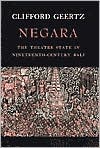Negara: The Theatre State in 19th Century Bali
Combining great learning, interpretative originality, analytical sensitivity, and a charismatic prose style, Clifford Geertz has produced a lasting body of work with influence throughout the humanities and social sciences, and remains the foremost anthropologist in America.\ His 1980 book Negara analyzed the social organization of Bali before it was colonized by the Dutch in 1906. Here Geertz applied his widely influential method of cultural interpretation to the myths, ceremonies, rituals,...
Search in google:
Combining great learning, interpretative originality, analytical sensitivity, and a charismatic prose style, Clifford Geertz has produced a lasting body of work with influence throughout the humanities and social sciences, and remains the foremost anthropologist in America.His 1980 book Negara analyzed the social organization of Bali before it was colonized by the Dutch in 1906. Here Geertz applied his widely influential method of cultural interpretation to the myths, ceremonies, rituals, and symbols of a precolonial state. He found that the nineteenth-century Balinese state defied easy conceptualization by the familiar models of political theory and the standard Western approaches to understanding politics.Negara means "country" or "seat of political authority" in Indonesian. In Bali Geertz found negara to be a "theatre state," governed by rituals and symbols rather than by force. The Balinese state did not specialize in tyranny, conquest, or effective administration. Instead, it emphasized spectacle. The elaborate ceremonies and productions the state created were "not means to political ends: they were the ends themselves, they were what the state was for.... Power served pomp, not pomp power." Geertz argued more forcefully in Negara than in any of his other books for the fundamental importance of the culture of politics to a society.Much of Geertz's previous work--including his world-famous essay on the Balinese cockfight--can be seen as leading up to the full portrait of the "poetics of power" that Negara so vividly depicts. The New York Review of Books The main purpose of Geertz's study is to delineate the general structure of the Negara by focusing on one particularly well-documented case, that of Bali in the era preceding the Dutch invasion of 1906. The outcome is a fascinating and remarkable book.
IllustrationsixPrefacexiIntroduction Bali and Historical Method3Chapter 1Political Definition: The Sources of OrderThe Myth of the Exemplary Center11Geography and the Balance of Power19Chapter 2Political Anatomy: The Internal Organization of the Ruling ClassDescent Groups and Sinking Status26Clientship34Alliance39Chapter 3Political Anatomy: The Village and the StateThe Village Polity45The Perbekel System54The Politics of Irrigation68The Forms of Trade87Chapter 4Political Statement: Spectacle and CeremonyThe Symbology of Power98The Palace as Temple109Cremation and the Struggle for Status116Conclusion Bali and Political Theory121Notes137Glossary259Bibliography267Index289
\ The New York Review of BooksThe main purpose of Geertz's study is to delineate the general structure of the Negara by focusing on one particularly well-documented case, that of Bali in the era preceding the Dutch invasion of 1906. The outcome is a fascinating and remarkable book.\ \








